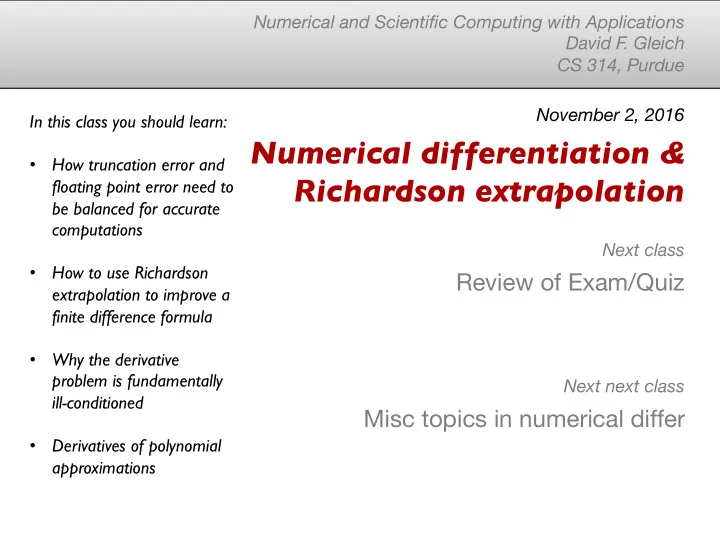

Numerical and Scientific Computing with Applications David F . Gleich CS 314, Purdue November 2, 2016 In this class you should learn: Numerical differentiation & • How truncation error and Richardson extrapolation floating point error need to be balanced for accurate computations Next class • How to use Richardson Review of Exam/Quiz extrapolation to improve a finite difference formula • Why the derivative problem is fundamentally Next next class ill-conditioned Misc topics in numerical differ • Derivatives of polynomial approximations
Numerical differentiation Key points Numerical accuracy is tricky with regular grids Polynomial representations make differentiation “easy” (we’ll see this today!) There are some standard approaches to improve the accuracy of numerical derivatives on regular grids. (Richardson extrapolation)
Numerical Methods for Applied Math Error 1/Approx 1 1. Take the continuous problem. e.g. integral Error 2/Approx 2 2. Compute a discrete representation. Error 3/Approx 3 3. Determine where to apply continuous & discrete properties to derive a tractable problem. e.g. linear system Error 4/Approx 4 4. Solve the tractable problem. e.g. LU factorization
Numerical Methods for Applied Math 1. Take the continuous problem. Compute f 0 ( x ) e.g. integral Given f ( x ) 2. Compute a discrete representation. 1 3. Determine where to apply h [ f ( x + h ) − f ( x )] continuous & discrete properties to derive a tractable problem. e.g. linear system [ˆ f ( x � h ) ˆ f ] ↵ h 4. Solve the tractable problem. ˆ f = floating point e.g. LU factorization function f
Demo Forward difference f 0 ( x ) = 1 h [ f ( x + h ) − f ( x )] + O ( h ) Central difference f 0 ( x ) = 1 2 h [ f ( x + h ) − f ( x − h )] + O ( h 2 )
Recommend
More recommend